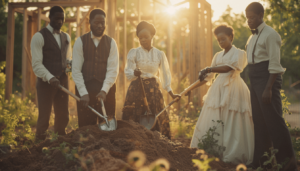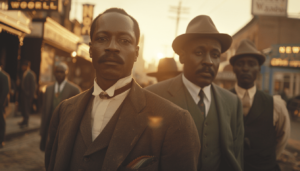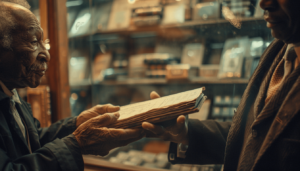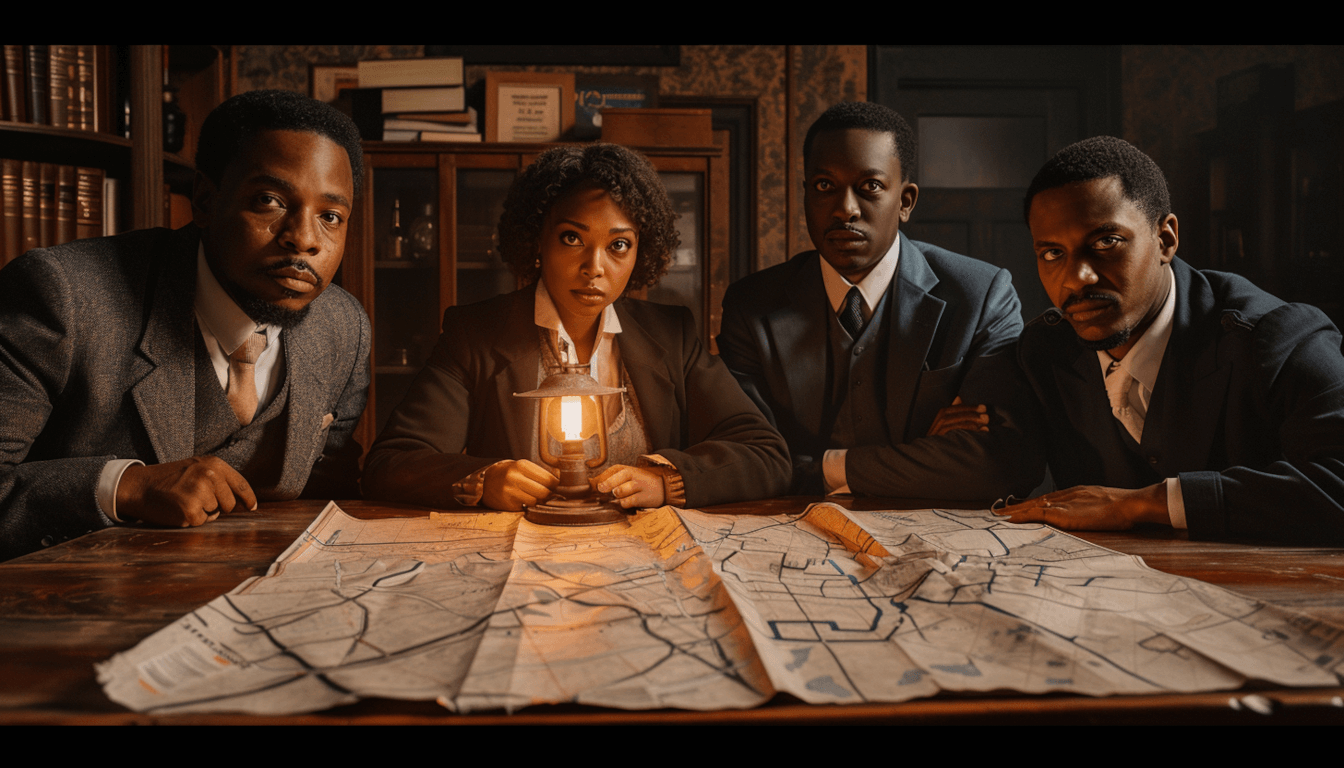This article introduces the founders and visionaries who transformed Tulsa’s Greenwood District into Black Wall Street—a thriving hub of Black enterprise in the early 20th century.
By 1920, Greenwood covered more than 35 busy blocks near Greenwood Avenue and Archer Street. The area supported doctors, lawyers, hotels, theaters, a hospital, a Y.M.C.A., a roller rink, and a post office substation.
The local economy was dense: dollars reportedly circulated nearly 30 times within the neighborhood. Entrepreneurs such as O.W. Gurley and J.B. Stradford organized capital, purchased land, and funded businesses that anchored daily life.
The story that follows balances celebration of growth with an unflinching account of the 1921 destruction that reshaped the city and displaced thousands.
Key Takeaways
- Greenwood became a concentrated hub of professionals, shops, and institutions by 1920.
- Local leaders pooled resources to create an economy where money cycled rapidly.
- O.W. Gurley and J.B. Stradford played central roles in land, finance, and civic life.
- The 1921 attack destroyed over 35 blocks and displaced most of 10,000 residents.
- The neighborhood’s rise and loss highlight both community agency and systemic violence.
The Greenwood District: Origins and the Rise of Black Wall Street
The Greenwood District emerged from deliberate land claims and strategic planning following the late 19th-century Oklahoma openings. Black entrepreneurs acquired lots north of the Frisco tracks, designing a vibrant corridor of homes and businesses that served upwardly mobile residents.
From Land Rush to Greenwood Avenue
In 1905–06, O.W. Gurley laid the foundation for Greenwood’s growth. He opened a grocery store, subdivided land, and promoted Greenwood Avenue as the spine of a self-sufficient Black community.
Segregation and the Rise of a Parallel Economy
Legal and social segregation barred Black residents from white-owned firms. In response, Greenwood developed its own banking, retail, and professional services. Money circulated repeatedly within the district, strengthening local ownership and economic resilience.
Education, Faith, and Community Institutions
Institutions anchored Greenwood’s daily life. Mt. Zion Baptist Church (1909) and Booker T. Washington High School embodied high expectations. Teachers earned competitive pay, classrooms featured Steinway pianos, and principal E.W. Woods lived in a six-room townhouse—symbolizing the district’s commitment to excellence.
|
Year |
Institution |
Role |
|
1905–06 |
Private Lots Along Greenwood Avenue |
Residential and commercial platting |
|
1909 |
Mt. Zion Baptist Church |
Religious and civic anchor |
|
Early 1900s |
Booker T. Washington High School |
Advanced curriculum, high-paid faculty |
Greenwood’s rise illustrates how place-making, education, and trade can forge lasting economic strength—even in the face of systemic exclusion.
O.W. Gurley: Founder of Black Wall Street and Architect of Greenwood
O.W. Gurley arrived in Tulsa with a clear vision: to transform raw acreage into a thriving Black neighborhood. After participating in the 1893 Cherokee Outlet land run, he returned in 1905–06 to purchase large tracts north of the Frisco tracks. Gurley’s land strategy mapped parcels into buildable lots, laying the groundwork for what would become the Greenwood District.
Mapping Greenwood for Black Prosperity
Gurley’s real estate plan converted open land into a street grid of homes and businesses. He subdivided property and promoted Greenwood Avenue as the commercial spine of a self-sufficient Black community.
Grocery, Lodging, and the Gurley Hotel
Gurley opened a grocery store on Greenwood Avenue to meet daily needs and attract other entrepreneurs. He built the Gurley Hotel, owned apartments and townhouses, operated an employment agency, and helped establish a Masonic Lodge—creating infrastructure for upward mobility.
Trade Unions and Business Development
By 1910, local bricklayers formed Hod Carriers Local 199, accelerating construction across the district. Gurley’s layered investments in lodging, retail, and services generated steady demand and job pathways for Black workers and business owners.
The result was a durable marketplace—shaped by Gurley’s land vision and sustained by the entrepreneurs who followed. Greenwood’s rise was no accident; it was built on strategy, ownership, and community-centered leadership.
Read economic lessons that track how land assembly and small-business networks sustained growth.
J.B. Stradford: Legal Pioneer and Builder of Black Wall Street
Educated at Oberlin and Indiana Law School, J.B. Stradford turned legal skill into a business strategy in early Tulsa. He arrived in 1899, first developing rental units before taking on a larger hospitality project that reshaped local commerce.

The Stradford Hotel: Black Luxury in Greenwood
The Stradford Hotel at 301 N. Greenwood was the largest Black-owned hotel in the United States. With 54 suites, a dining room, saloon, pool hall, and gambling hall, it rivaled the finest accommodations in white Tulsa.
Valued at approximately $75,000—equivalent to $2.5 million today—the hotel served both travelers and local residents, symbolizing Black prosperity in the heart of the Greenwood District.
Legal Strategy and Economic Leadership
J.B. Stradford applied his legal training to structure real estate deals, secure property titles, and attract investors. His entrepreneurial vision expanded Greenwood’s hospitality sector and elevated business standards across Black Wall Street.
The hotel anchored nearby commerce, drawing foot traffic to shops, offices, and service providers. As a flagship enterprise, it supported local suppliers, trade unions, and professional practices—creating a ripple effect of economic opportunity.
Stradford’s project proved that Black Wall Street was not just aspirational—it was operational, resilient, and rooted in strategic ownership.
John and Loula Williams: Dreamland Theater and Greenwood’s Black Business Legacy
John and Loula Williams turned a small confectionary into a cultural magnet that reshaped nightly life in the district. Their Dreamland Theater became a destination for films, live acts, and community gatherings.

Confectionery, Theater, and Rooming Houses
John and Loula Williams began with a confectionery that drew steady foot traffic to nearby Greenwood shops. They later financed the Dreamland Theater, offering films and live performances that energized the district’s cultural life.
To support traveling performers and workers, the Williamses operated a rooming house—linking hospitality to entertainment and keeping dollars circulating within the Greenwood economy.
Family Enterprise and Community Employment
The Williams family treated business as civic duty. Their enterprises created jobs, mentored young people, and reinvested profits into shop repairs, local events, and neighborhood infrastructure. Their work exemplified Greenwood’s spirit of self-sufficiency, cultural pride, and economic resilience.
“Dreamland made people proud to come out in the evening.”
Their model showed how adaptive businesses—concessions, venues, and lodging—built resilience. For more on local economic strategies that supported such ventures, see a detailed account in this economic profile.
A.J. Smitherman and the Tulsa Star: Journalism, Justice, and the Fight for Greenwood
The Tulsa Star became a civic bulwark, chronicling threats while promoting local commerce. A.J. Smitherman built one of two African American newspapers that served the district with reporting, analysis, and moral urgency.

The paper informed residents about lynchings across Oklahoma during an era of Jim Crow segregation. When city institutions failed, the Star documented abuses and urged collective action.
The newsroom also strengthened businesses. Advertising, event notices, and storefront profiles helped merchants recruit staff and attract customers across neighborhood lines.
- Advocacy: The Star pressed for civil rights and local safety.
- Information: It gave residents timely warnings about threats.
- Confidence: Reliable coverage supported commerce and civic planning.
Historian Hannibal B. Johnson frames Greenwood’s economy as born of necessity after exclusion from the white market. That view clarifies how press and profit mixed to protect community life then and shape memory today. For deeper legal context, see a legal analysis of racial violence.
Simon Berry’s Greenwood Legacy: Buses, Air Charters, and Economic Mobility
Simon Berry turned transit into a business that stitched Greenwood to downtown Tulsa.

He ran Model T Fords and buses on set routes along Greenwood Avenue. Those lines carried residents to jobs, shops, and hotels in the wider city. Reliable schedules cut commute friction and boosted foot traffic for small businesses.
Berry’s services let people move quickly between commerce nodes. That flow raised demand for restaurants, venues, and retail. The link between transit and trade made him one of the era’s key entrepreneurs.
“His buses made Greenwood a hub that reached beyond its blocks.”
| Service | Vehicle | Impact |
|---|---|---|
| Local Routes | Model T Fords | Daily commutes for workers |
| Scheduled Buses | Motor Coach | Expanded customer reach for shops |
| Air Charters | Private Planes | Connected wealthy clients to regional deals |
By adding early air charters for oilmen, Berry tied neighborhood capital to regional markets. For a focused account, see this Simon Berry profile.
B.C. Franklin: Legal Architect of Greenwood’s Rebuilding After the Tulsa Race Massacre
May 31–June 1, 1921 marked a catastrophic assault that turned thriving commerce and homes into smoldering ruins. More than 35 square blocks were razed, roughly 1,000 houses burned, and an estimated 200–300 residents were killed. Survivors were held in National Guard internment centers as the city smoldered.

Legal work after the violence became essential to restoring the neighborhood’s civic life. Attorney B.C. Franklin, who had only recently arrived, challenged municipal ordinances that aimed to prevent rebuilding. To hear firsthand accounts of survival, resilience, and rebuilding, explore our collection of Personal Stories from the Survivors of Black Wall Street
Legal Challenges To Discriminatory Ordinances
Franklin’s courtroom strategy dismantled rules that would have blocked permits, insurance recovery, and financing. Those rulings reopened channels for claims on destroyed buildings and for approval of new construction.
- The legal wins helped residents recover insurance and obtain permits for rebuilding houses and commercial blocks.
- They restored the community’s ability to secure loans and restart businesses along familiar corridors similar to wall street-like hubs.
- By defending property rights, legal advocacy became a form of community defense that enabled gradual economic renewal.
“Court decisions after 1921 reaffirmed the right to rebuild and reclaim space for daily life.”
For more on Franklin’s life and legal legacy, see a B.C. Franklin profile. For context on rebuilding commercial life, consult this piece on building businesses then and now.
Black Wall Street Founders: The Visionaries Who Built Tulsa’s Greenwood District
A dense mix of hotels, shops, and professional offices made Tulsa’s Greenwood District a regional model of Black economic self-reliance. Its commercial corridor became a blueprint for community wealth, ownership, and civic pride.
Key Businesses and Professional Services in Greenwood
Greenwood Avenue served as the district’s economic spine, uniting banks, medical practices, legal offices, theaters, and lodging. These Black-owned enterprises kept earnings circulating locally and created reliable jobs for African American families across Tulsa.
Booker T. Washington’s Recognition and National Influence
Booker T. Washington famously called Greenwood “Negro Wall Street,” praising its concentration of Black-owned businesses and institutions. His recognition elevated the district’s national profile and affirmed its role as a symbol of Black prosperity and self-determination.
Schools, Families, and Generational Wealth
Booker T. Washington High School set high academic standards. Teachers earned competitive salaries, and principal E.W. Woods lived in a six-room townhouse that reflected the school’s prestige and community investment.
The school-to-career pipeline helped students gain admission to top universities and enter Tulsa’s growing Black professional class. Over generations, this educational foundation supported household stability, mentorship, and reinvestment—fueling Greenwood’s legacy of resilience and upward mobility.
- Schools and schools-linked jobs: prepared youth for professions.
- Businesses: anchored family incomes and local credit flows.
- Community institutions: reinforced civic trust and long-term planning.
Final Thoughts: Greenwood’s Legacy of Vision, Resilience, and Rebuilding
Greenwood’s rise was no accident—it was the result of strategic land ownership, disciplined business practices, and strong civic institutions. Black entrepreneurs transformed purchased acreage into hotels, grocery stores, rooming houses, theaters, and professional offices that kept wealth circulating within the community.
The 1921 Tulsa Race Massacre destroyed more than 35 blocks and erased an estimated $2 million in property value—equivalent to over $50 million today. Yet legal action by B.C. Franklin reopened pathways to rebuild homes, businesses, and civic infrastructure, even as leaders like O.W. Gurley and J.B. Stradford suffered devastating losses.
Educators, a rigorous high school pipeline, family enterprises like those led by Loula Williams, and transit systems sustained daily life and cultivated generational talent. Greenwood’s legacy endures not only in memory but in the continued fight for recognition, justice, and reparative action.
For a deeper look at federal findings and historical accountability, see the Justice Department’s Report on the Tulsa Race Massacre: Acknowledging the Past, Building the Future.
Related Articles: Founders and Visionaries of Black Wall Street
- Founders and Visionaries of Black Wall Street
Explore the leaders who transformed Greenwood into a national model of Black economic power. - O.W. Gurley: A Founder of Prosperity
Learn how Gurley’s land strategy and civic vision laid the foundation for Black Wall Street. - J.B. Stradford: The Visionary Behind Black Wall Street
Discover how Stradford’s hotel, legal work, and economic leadership shaped Greenwood’s rise. - Personal Stories from the Survivors of Black Wall Street
Hear firsthand accounts from those who lived through the 1921 Tulsa Race Massacre and rebuilt. - Justice Department’s Report on the Tulsa Race Massacre: Acknowledging the Past, Building the Future
Review federal findings and calls for accountability in the aftermath of Greenwood’s destruction.
Historical Resources and Archival References
- O.W. Gurley – Wikipedia
Overview of Gurley’s role in founding Greenwood and shaping Black Wall Street through land ownership and civic leadership. - The Bezos of Black Wall Street – Forbes
A modern reflection on Black entrepreneurship in Greenwood and the economic impact of the 1921 Tulsa Race Massacre. - Tulsa’s Black Legal History – UA Little Rock Law Review
Scholarly analysis of legal responses to the massacre and the role of attorneys like B.C. Franklin in defending survivors. - The Victory of Greenwood – Simon Berry Profile
Tribute to Simon Berry’s transportation and aviation legacy in Greenwood’s economic infrastructure. - Franklin “Buck” Colbert – BlackPast
Biography of B.C. Franklin, highlighting his legal advocacy and role in rebuilding Greenwood after the massacre.
